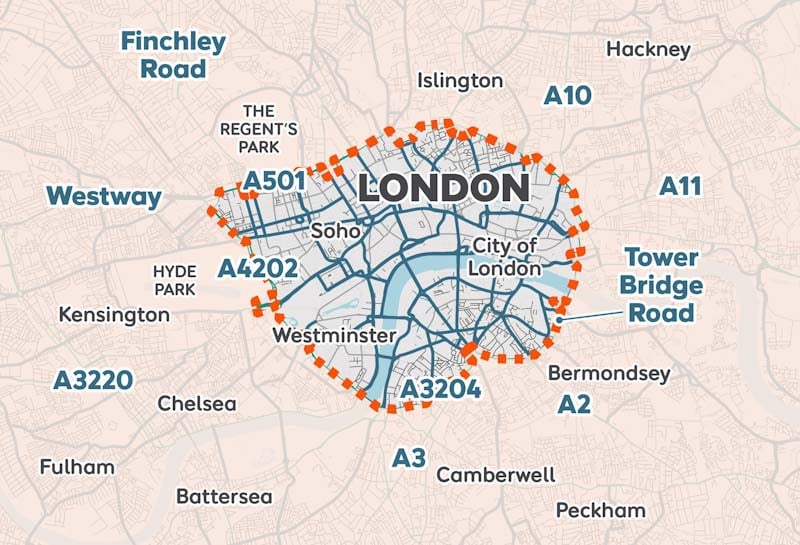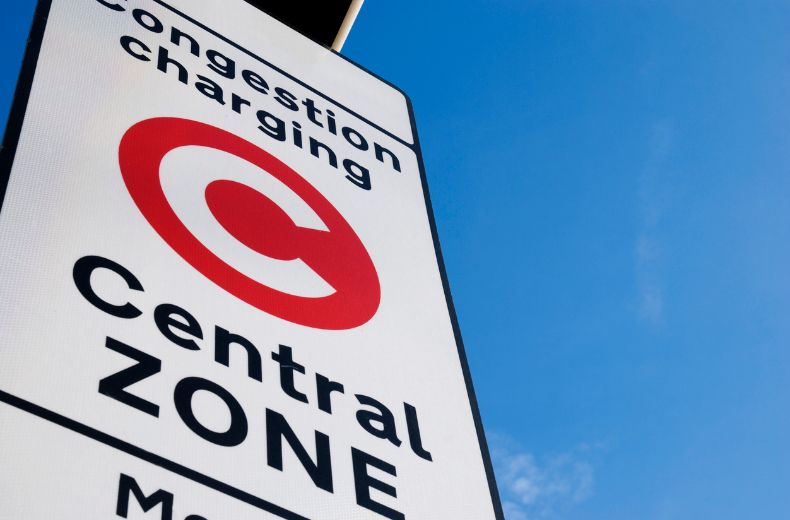Our guide details all you need to know about the London Congestion Charge, including when it applies, how much you have to pay, the penalties for not paying and how you can appeal a C-Charge fine.
What is the London Congestion Charge?
The Congestion Charge is a fee for driving in central London at certain times of the day. Its aim is to reduce traffic congestion by making people think twice before using their cars.
Managed by Transport for London (TfL), the Congestion Charge covers approximately the area from Kings Cross in the north to Vauxhall in the south, and Paddington in the west to Whitechapel in the east. All roads around the perimeter of the zone are monitored by Automatic Number Plate Recognition (ANPR) cameras.

Is the London Congestion Charge the same as ULEZ and LEZ?
The London Congestion Charge is separate to the Ultra Low Emission Zone (ULEZ) and Low Emission Zone (LEZ), which means you may face additional fees to drive in certain parts of London.
The ULEZ and LEZ are designed to reduce air pollution, while the Congestion Charge is intended to reduce traffic congestion in central London.
How much is the London Congestion Charge?
The London Congestion Charge is £15 per day, if you pay in advance or on the day of travel. The fee increases to £17.50 if you pay by midnight on the third day after your journey. .
What times does the London Congestion Charge operate?
The charge applies seven days a week between 7:00 am and 18:00 pm Monday to Friday; and 12:00 to 18:00 Saturday to Sunday (and bank holidays).
There is no charge on Christmas Day or New Year's Day.
How do I pay the London Congestion Charge?
You can pay the Congestion Charge online via the TFL website or at selected newsagents and petrol stations in the London area.
There are also around 100 blue and red self-service machines in car parks inside the zone. These only accept credit and debit cards, though – no cash.
Regular users can also register for automatic payment (Auto Pay), which provides a discount of £1 per day.
Beware of fake Congestion Charge websites that promise to pay TFL on your behalf. They may charge an additional fee for this service – and there is no guarantee they will pass payment on to TFL.
Who is exempt from the London Congestion Charge?
If you can prove you live in within the C-Charge zone, you will be entitled to a 90% residents’ discount.
The following are exempt from the Congestion Charge altogether, subject to a £10 annual registration fee:
- Disabled drivers with a Blue Badge
- Petrol cars with emission standards of Euro 5 or 6 (NOx)
- Electric car drivers (and any other zero emissions vehicles)
- Vehicles with nine or more seats
- Motorised tricycles
- Motorcycle riders do not have to pay the C-Charge, or register for exemption
Do electric cars pay the London Congestion Charge?
No, electric car drivers are exempt from paying the Congestion Charge until 24 December 2025. To qualify for this exemption, you will need to apply for a Cleaner Vehicle Discount, otherwise you will be required to pay the daily Congestion Charge fee.
How do I avoid paying the London Congestion Charge?
You can avoid paying the London Congestion Zone Charge by travelling between 18:00 and 7:00 Monday to Friday, and 18:00 to 12:00 Saturday to Sunday (and bank holidays). There is no charge between Christmas Day or New Year's Day, either.
Which cars pay the London Congestion Charge?
Drivers of cars with emission standards of:
- Petrol: Euro 4 (NOx)
- Diesel: Euro 6 (NOx and PM)
have to pay the C-Charge if they enter central London during the specified times.
This includes the vast majority of cars on the road, apart from electric, hydrogen and some plug-in hybrid models.
Drivers of foreign-registered cars also have to pay, or risk a fine.
- What's my car's Euro standard?
- The Dartford Crossing Charge: what, how and why you pay it
- Clean Air Zones – what are they and where are they?
Can I be fined for not paying the London Congestion Charge?
If you fail to pay by midnight the day after you drive in the C-Charge zone, you’ll receive a Penalty Charge Notice (PCN). The fine is £180, or £90 if paid within 14 days.
How do I pay a London Congestion Charge fine?
Fines can also be paid via the TFL website. You’ll need your PCN and car registration numbers to hand.
Can I appeal a London Congestion Charge fine?
If you think a Congestion Charge fine has been issued unfairly, you can appeal. The reasons stated for making an appeal are:
- You were not the keeper at the time of the contravention
- You had paid the charge
- Your vehicle was exempt
- The vehicle was used or taken without your consent
- You had registered for a 100% discount
- The vehicle was on hire to someone else
However, TFL says it will ‘consider representations made on any other grounds’.
You can challenge the PCN by writing to the following address: Congestion Charging, PO Box 344, Darlington, DL1 9QE.
Alternatively, you can contest the PCN via the TFL website. You have 28 days from the date the PCN was issued to either pay or appeal.
If you have any questions about a PCN, you can telephone 0343 222 3333. Lines are open from 8:00 to 20:00 and calls cost between 2p and 10p per minute from landlines, or 10p and 40p from mobiles.

Cheaper than AA or we’ll beat by 20%^
• Roadside cover from £5.49 a month*
• We get to most breakdowns in 60 mins or less
• Our patrols fix 4/5 breakdowns on the spot

When was the London Congestion Charge brought in?
The Congestion Charge was introduced in 2003 by then Mayor of London, Ken Livingstone. Initially, it cost £5 a day, but the fee has trebled to £15 a day for most drivers.
A ‘Western Extension’ to the C-Charge zone, covering much of Kensington, Chelsea and Earl’s Court, was introduced in 2007. However, following protests from residents and local businesses, it was eventually removed at the end of 2010.
Congestion charge FAQ
- How do I know if I have to pay Congestion Charge?
You will need to pay a daily charge if you drive within London’s Congestion Charge zone between 07:00-18:00 Mon-Fri, 12:00-18:00 Sat-Sun, and on Bank Holidays. There is no charge between Christmas Day and New Year’s Day bank holiday (inclusive). Visit the TfL website for more information.
- Can I check if I have driven in the congestion zone?
The only way to know if you will be driving into the London Congestion Zone is by checking the official map on the TfL website. They will also be signposted on the roads across London.
- Where does the Congestion Charge start and finish?
The Congestion Charge in London covers approximately the area from Kings Cross in the north to Vauxhall in the south, and Paddington in the west to Whitechapel in the east. All roads around the perimeter of the zone are monitored by Automatic Number Plate Recognition (ANPR) cameras.
- What do I do if I forgot to pay Congestion Charge?
If you fail to pay for the London Congestion Charge by midnight on the third day after travel in the zone, you will receive a Penalty Charge Notice (PCN). This could lead to a £100 fine and three points on your licence.













